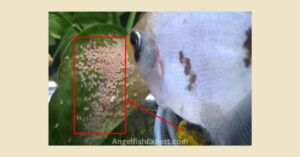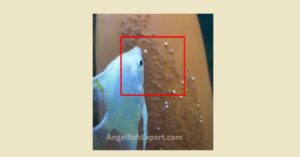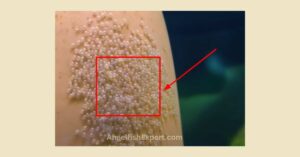
Breeding freshwater aquarium fish is a pleasing experience. Among freshwater species, angelfish are very popular, and a lot of aquarists will try to breed them. Breeding angelfish contains a few challenges in each of the different steps. One of them initially involves choosing mates.
How to Care for Angelfish Eggs and Angelfish Fry
In order to care for angelfish eggs and angelfish fry, it includes steps and precautions to make sure that angelfish eggs are safely guarded and angelfish fry are properly nourished.
Following are the proper guidelines for how to breed angelfish:
Arrange the tank
To locate the angelfish, you need to prepare the tank. Always choose a spacious tank to keep your pet, as they are unable to reproduce if they are kept in a compacted area.
Provide Filtration system
The filtering system should be good. Maintain the proper flow filter for the tank. You can use a gravel filter, a sponge filter, or both.
Regulate the water temperature
Water temperature plays a very important role in angelfish breeding, so you should regulate the water temperature. Angelfish can reproduce at several temperatures. Lukewarm water is best for their growth. Ideal temperatures range from 25°C to 30°C.
Regulate Water pH
Water pH plays an important role in breeding your angelfish. High pH levels are not favorable for angelfish to breed. Make sure that your tank’s pH is between 6.0 and 8.0. Angelfish like slightly acidic and alkaline water.
Proper Diet
A proper diet is very necessary to produce healthy eggs. Feed them twice or three times a day at a minimum.
How to take care of Angelfish Eggs

When it comes to keeping the angelfish eggs safe, allow the parents to care for the eggs themselves or artificially hatch the eggs yourself. If leaving the eggs with the adults if you’re going with this preference, be cautious that it could take the angelfish couple a few spawns earlier than they are able to enhance the tiny angelfish without consuming them.

You have to be conscious if making a decision no longer to get rid of the eggs after spawning due to the fact angelfish will eat their very own eggs or fry. Any sort of stress leads angelfish to eat their very own eggs and fry. Suitable water high-quality, the right feeding, and a proper tank set-up can hold back the nature of angelfish.
Feed the angelfish with the high-quality substance at intervals, even all through the hatching duration. Now not to overfeed them, as a few angelfish are so eaten up via guarding the eggs. Avoid making angelfish feel nervous by crowding the tank. To not allow this to appear, pass the tank to a peaceful and calm area.
By taking advantage of this approach, the parents deal with the eggs and juveniles till they are able to cope with themselves. Later, the eggs are aerated and cleaned by making them dirt free. If spawning takes place spontaneously, dispose of the fish that would attack the eggs, especially in case you note signs and symptoms of aggression from angelfish towards each other.
Be patient, and offer them the right conditions; most of the angelfish cooperate with this and provide an upward push to their parenting. In some situations, they will not do this; you have to hatch the eggs artificially.
How do you know if angelfish eggs are fertilized?
The color of the angelfish eggs is the first way to tell if they were fertilized. In most instances, it ranges from the color amber to brown, which gives the strongest sign.
The following symptoms are noticed if your angelfish eggs have been fertilized
According to the Japanese Journal of Ichthyology[1], If their eggs sink to the bottom of the tank, they might not get enough air and could die. That’s why it’s important for the eggs to float in the tank. If they sink to the bottom of the tank, they might not get enough air and could die or not grow properly.
- Fertilized eggs have a higher balance than unfertilized eggs.
- Fertilized eggs have a gelatinous consistency.
- Furthermore, healthy eggs are clean and easily float.
Angelfish Egg Stages
It includes the stages from cleaning the location of breeding to the last stage of Fry where tiny angelfish appear. The spawning area is cleaned up by the mating angelfish so that the female can lay eggs.
| Stage | Characteristics | Duration |
|---|---|---|
| Fertilized | After the male and female angelfish have spawned, eggs are fertilized | 0-1 day |
| Cleavage | The zygote begins to divide into multiple cells | 1-2 days |
| Blastula | The embryo forms into a hollow ball of cells | 2-3 days |
| Gastrulation | The embryo starts to develop distinct layers of tissue | 3-4 days |
| Heartbeat | The embryo’s heart starts to beat | 4-5 days |
| Hatching | The fry start to emerge from their eggs | 5-7 days |
Laying Eggs

Angelfish only lay eggs when there are favorable conditions in the tank, including water quality, filtering system, temperature, and pH of the water. The spawning area is cleaned up by the mating angelfish so that the female can lay eggs.
Pre-hatching stage
In no more than a few short hours, after the female laid her eggs, the male angelfish could have fertilized them. In maximum cases, the color of the egg modifications in coloration takes place.
Stage of Larval
Throughout this degree, the eggs begin to flow around on their own and emerge as self-reliant. The larval stage begins after two to three days of hatching. Larvae appear like worms.
Stage of Fry
The larvae will sooner or later turn into independent flies. Fry is now capable of swimming for some distance.
The Final Stage
Finally, tiny angelfish appear a few days after the fry stage.
How to Care for Angelfish Fry

As soon as the angelfish babies start to swim independently, they’ll soon start to search for food.
Meanwhile, the parents’ angelfish will have a tough time protecting them from other fish that may raid them for meals. Doing away with them from the aquarium will increase their probability of survival. So separate the tiny angelfish and shift it to a different tank.
Different stages of Angelfish Fry development
Angelfish Fry typically goes through four stages of development:
Eggs stage
The first stage is when the female Angel lays the eggs on a clean surface. The eggs are usually a light yellow color and are attached to the spawning slate or another substrate.
Wrigglers Stage
After about 3 to 4 days, the eggs will hatch into wrigglers. At this point, the fry is still attached to the spawning slate and is not yet free-swimming. They will wiggle around in order to get food from the yolk sac that they carry.
Start Free-swimming
Around day 5 or 6, the fry will become free-swimming. This means that they will start to swim around on their own, and will no longer be attached to the spawning slate. At this stage, it’s important to feed them small amounts of newly hatched brine shrimp or other suitable food several times a day.
Juvenile
As the fry grows and develops, it will move into the juvenile stage. At this point, they will start to develop their distinctive angelfish shape and coloration. They should be fed a varied diet that includes live or frozen foods, as well as high-quality dry foods.
Here’s a table summarizing the different stages of Angelfish Fry development:
| Stage | Characteristics | Duration |
| Eggs | Light yellow color, attached to clean substrate | |
| Wrigglers | Fry still attached to the spawning slate, wiggling to obtain food | 2-3 days |
| Free-swimming | Fry swim freely, need to be fed small amounts multiple times a day | 3-4 weeks |
| Juvenile | Develop distinctive shape and coloration, require a varied diet | 2-3 months+ |
It’s important to note that these timeframes are estimates and can vary depending on factors such as water temperature and quality, as well as the health of the fry. Proper care and attention can help ensure that your Angelfish Fry develops into a healthy adult.
Feeding the Angelfish Fry
It’s easy to feed angelfish fry; a special diet is necessary for them. Commercially available fry food isn’t always enough, and you also want to feed them newly hatched brine shrimp or micro worms. Bringing shrimp that are 12 hours old isn’t suitable because an angelfish’s mouth is too small to eat that shrimp.
The first feeding of the angelfish babies should get started when they’ve been transferred to the new tank.
Newly hatched brine shrimp are the main ingredient for angelfish fry. In case you need to grow the juveniles fast, feed them frequently with a small quantity every time.
Always feed them in smaller quantities, as overfeeding will lead to them fouling the water. After 3 to 4 weeks, you can feed them crushed fish flakes in small quantities and increase the amount day by day. At 4 to 6 weeks, you can provide them with flakes or pellets to eat.
Conclusion
Caring for angelfish eggs and fry can be rewarding but requires attention to detail. By following our guide, you can ensure that your angelfish babies grow up healthy and happy. Remember to maintain good water quality and temperature, protect the eggs from predators, and provide the right nutrition for optimal growth. With these tips and tricks, you’ll be a pro at raising angelfish in no time! Start your journey to successful angelfish breeding today with our comprehensive care guide.